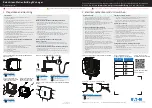
Driving on Snow or Ice
Most of the time, those places where the tires
meet the road probably have good traction.
However, if there is snow or ice between the tires
and the road, you can have a very slippery
situation. You will have a lot less traction, or grip,
and will need to be very careful.
What is the worst time for this? Wet ice. Very cold
snow or ice can be slick and hard to drive on.
But wet ice can be even more trouble because it
may offer the least traction of all. You can get
wet ice when it is about freezing, 32°F (0°C), and
freezing rain begins to fall. Try to avoid driving
on wet ice until salt and sand crews can get there.
Whatever the condition — smooth ice, packed,
blowing, or loose snow — drive with caution.
If you have the Traction Control System (TCS), it
will improve your ability to accelerate when
driving on a slippery road. But you can turn the
TCS off if you ever need to. You should turn
the system off if your vehicle ever gets stuck in
sand, mud, ice, or snow. See
If Your Vehicle
is Stuck in Sand, Mud, Ice, or Snow on page 331
.
Even if your vehicle has TCS, you will want to
slow down and adjust your driving to the
road conditions. Under certain conditions, you may
want to turn the TCS off, such as when driving
through deep snow and loose gravel, to help
maintain vehicle motion at lower speeds. See
Traction Control System (TCS) on page 310
.
328
Summary of Contents for 2007 Rendezvous
Page 6: ...These are some examples of symbols that may be found on the vehicle 6 ...
Page 32: ...Put someone on it Get it up to speed Then stop the vehicle The rider does not stop 32 ...
Page 106: ... NOTES 106 ...
Page 170: ... NOTES 170 ...
Page 173: ... NOTES 173 ...
Page 174: ...Instrument Panel Overview 174 ...
Page 300: ... NOTES 300 ...
Page 364: ...Engine Compartment Overview When you lift the hood this is what you see 364 ...
Page 470: ... NOTES 470 ...
Page 487: ...Engine Drive Belt Routing 3 5L V6 Engine 487 ...
Page 512: ... NOTES 512 ...















































